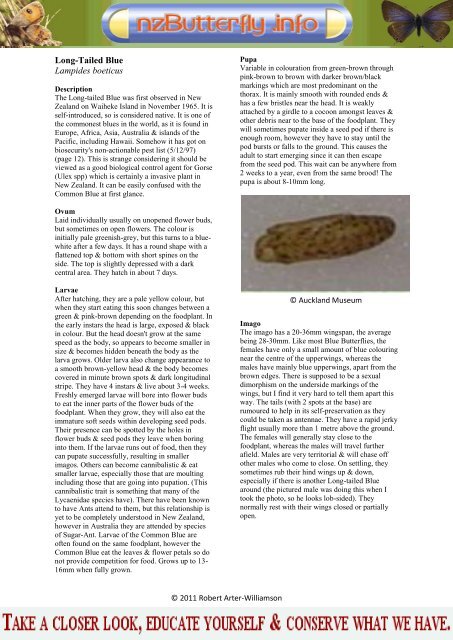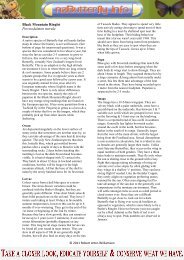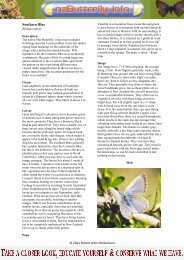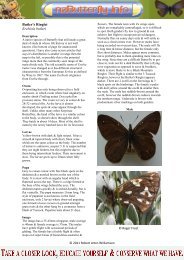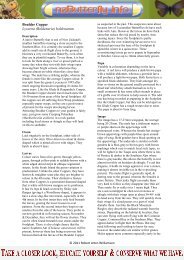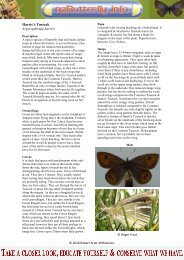Long-Tailed Blue Lampides boeticus - NZ Butterfly Info
Long-Tailed Blue Lampides boeticus - NZ Butterfly Info
Long-Tailed Blue Lampides boeticus - NZ Butterfly Info
- No tags were found...
Create successful ePaper yourself
Turn your PDF publications into a flip-book with our unique Google optimized e-Paper software.
<strong>Long</strong>-<strong>Tailed</strong> <strong>Blue</strong><strong>Lampides</strong> <strong>boeticus</strong>DescriptionThe <strong>Long</strong>-tailed <strong>Blue</strong> was first observed in NewZealand on Waiheke Island in November 1965. It isself-introduced, so is considered native. It is one ofthe commonest blues in the world, as it is found inEurope, Africa, Asia, Australia & islands of thePacific, including Hawaii. Somehow it has got onbiosecurity's non-actionable pest list (5/12/97)(page 12). This is strange considering it should beviewed as a good biological control agent for Gorse(Ulex spp) which is certainly a invasive plant inNew Zealand. It can be easily confused with theCommon <strong>Blue</strong> at first glance.PupaVariable in colouration from green-brown throughpink-brown to brown with darker brown/blackmarkings which are most predominant on thethorax. It is mainly smooth with rounded ends &has a few bristles near the head. It is weaklyattached by a girdle to a cocoon amongst leaves &other debris near to the base of the foodplant. Theywill sometimes pupate inside a seed pod if there isenough room, however they have to stay until thepod bursts or falls to the ground. This causes theadult to start emerging since it can then escapefrom the seed pod. This wait can be anywhere from2 weeks to a year, even from the same brood! Thepupa is about 8-10mm long.OvumLaid individually usually on unopened flower buds,but sometimes on open flowers. The colour isinitially pale greenish-grey, but this turns to a bluewhiteafter a few days. It has a round shape with aflattened top & bottom with short spines on theside. The top is slightly depressed with a darkcentral area. They hatch in about 7 days.LarvaeAfter hatching, they are a pale yellow colour, butwhen they start eating this soon changes between agreen & pink-brown depending on the foodplant. Inthe early instars the head is large, exposed & blackin colour. But the head doesn't grow at the samespeed as the body, so appears to become smaller insize & becomes hidden beneath the body as thelarva grows. Older larva also change appearance toa smooth brown-yellow head & the body becomescovered in minute brown spots & dark longitudinalstripe. They have 4 instars & live about 3-4 weeks.Freshly emerged larvae will bore into flower budsto eat the inner parts of the flower buds of thefoodplant. When they grow, they will also eat theimmature soft seeds within developing seed pods.Their presence can be spotted by the holes inflower buds & seed pods they leave when boringinto them. If the larvae runs out of food, then theycan pupate successfully, resulting in smallerimagos. Others can become cannibalistic & eatsmaller larvae, especially those that are moultingincluding those that are going into pupation. (Thiscannibalistic trait is something that many of theLycaenidae species have). There have been knownto have Ants attend to them, but this relationship isyet to be completely understood in New Zealand,however in Australia they are attended by speciesof Sugar-Ant. Larvae of the Common <strong>Blue</strong> areoften found on the same foodplant, however theCommon <strong>Blue</strong> eat the leaves & flower petals so donot provide competition for food. Grows up to 13-16mm when fully grown.© Auckland MuseumImagoThe imago has a 20-36mm wingspan, the averagebeing 28-30mm. Like most <strong>Blue</strong> Butterflies, thefemales have only a small amount of blue colouringnear the centre of the upperwings, whereas themales have mainly blue upperwings, apart from thebrown edges. There is supposed to be a sexualdimorphism on the underside markings of thewings, but I find it very hard to tell them apart thisway. The tails (with 2 spots at the base) arerumoured to help in its self-preservation as theycould be taken as antennae. They have a rapid jerkyflight usually more than 1 metre above the ground.The females will generally stay close to thefoodplant, whereas the males will travel furtherafield. Males are very territorial & will chase offother males who come to close. On settling, theysometimes rub their hind wings up & down,especially if there is another <strong>Long</strong>-tailed <strong>Blue</strong>around (the pictured male was doing this when Itook the photo, so he looks lob-sided). Theynormally rest with their wings closed or partiallyopen.© 2011 Robert Arter-Williamson
MaleStatusCommon throughout its range. It is known to be amigratory species, so the native population possiblyhas a boost with migrants from Australia.DistributionFemaleUndersidePhenologyNote: this is a guide only based on Australianpopulations & general flight times of imagos. NewZealand records show all stages can be found allyear round. A lot more research needs to be done toimprove accuracy.HabitatOpen country & gardens where foodplants grow.Food PlantsBroom (Cytisus spp), Peas (Pisum sativum), SweetPea (Lathyrus odoratus), Broad Bean (Vicia faba),Gorse (Ulex spp), Lupin (Lupinus spp), TreeLucerne (Chamaecytisus palmensis) & Rattlepodfamily (Crotalaria spp).CopyrightAll content belongs to Robert Arter-Williamsonand www.nzbutterfly.info.Factsheet Design lay out by Stuart Desjardins.© 2011 Robert Arter-Williamson


